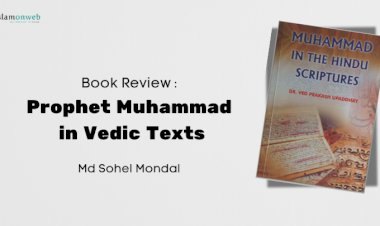Celebrating the Beloved: Annemarie Schimmel’s Insights into the Mawlid Tradition in ''And Muhammad Is His Messenger''
Annemarie Schimmel, born in Erfurt, Germany, in 1922, was a renowned German orientalist whose literary contributions predominantly focused on Islamic topics. She authored over fifty books and published numerous articles on Islamic literature, history, culture, and mysticism, earning recognition from prominent Islamic scholars and Sufis. As a multilingual scholar fluent in German, Turkish, and English, she also spoke Arabic, Urdu, Persian, and Punjabi, which greatly enriched her poetic translations and scholarly pursuits.
In her book And Muhammad Is His Messenger—an English translation of her 1981 German work Und Muhammad Ist Sein Prophet—Schimmel explores the life of Prophet Muhammad ﷺ, delving into his birth, marriage, and ethereal journey, among other aspects. She discusses these themes within the context of practices observed by Muslims worldwide. Her writings serve as a valuable resource for readers seeking a deeper understanding of Islamic religious culture and traditions.
In the eighth chapter, titled “The Celebration of the Prophet’s Birthday,” Schimmel examines the miraculous events surrounding the birth of Muhammad ﷺ .She discusses various mawlūds—poetry or literature written in honour of the Prophet’s birth and life—from diverse countries and regions, including Turkey, Egypt, the Arab world, Bangladesh, West Bengal, and the Indian subcontinent. She quotes numerous poetic texts in Sindhi, Turkic, and Punjabi to support the reliability of her accounts.
This chapter vividly describes the celebrations and practices held on the Prophet’s birthday, primarily on the 12th of Rabīʽ al-Awwal, the third month of the Islamic calendar. While there is some debate among Islamic scholars regarding the exact birth date of the Prophet ﷺ, the day is widely celebrated across Turkey, Egypt, Africa, Iraq, Bangladesh, and the Indian subcontinent. Schimmel highlights the significance of this day by citing three scholarly proofs, including interpretations by the Mālikī mufti of Algiers, Ibn ‘Ammār, who links the event to the verses of Sūrat al-Qadr: “better than a thousand months.”
Addressing the essence of the Prophet’s birthday celebration, Schimmel provides an etymological and linguistic analysis of the word mawlid and its alternative term milād, both of which mean “birthday” or “anniversary.” She further explores the passive participle maulūd, derived from the Arabic root w-l-d, and notes its Turkish adaptation as mevlût or mevlûd.
Schimmel’s writing style is both moving and persuasive, marked by her exceptional literary background and meticulous choice of words. She effectively conveys her ideas through illustrative examples, such as: “We went to a mawlid in his house and listened to a classical mawlūd,” where she explains the nuanced distinction between maulid and maulūd.
Annemarie Schimmel presents the Islamic history of maulūd with clarity, drawing on significant events from the works of renowned scholars. She traces the origins of the maulūd celebration to Egypt during the Fatimid era (969–1171), highlighting its emergence in 1121 based on the accounts of the Egyptian historian al-Maqrīzī. Schimmel describes the 1121 celebration in detail, noting activities such as listening to sermons, distributing sweets and honey—favourites of the Prophet ﷺ —and giving alms to the poor. She also recounts the maulūd festival of 1207 in Arbela, Northern Iraq, as documented by the historian Ibn Khallikān in his account of Ibn Dihya. Additionally, she provides insights into the Turkish celebration known as mevlût kandîlî or “the candle feast for the Prophet’s birthday,” which involves fasting until sunset.
Schimmel addresses the ongoing scholarly debates surrounding the mawlūd celebrations. She notes that Sunnis played a significant role in elaborating the tradition, while orthodox theologians often criticised it as bidʿa (innovation). For instance, she references the reformer Ibn Taymiyya and Mālikī theologians, particularly those from North Africa, who opposed the practice on the grounds that it coincides with the Prophet’s ﷺ commemoration day and thus constitutes an innovation.
However, Schimmel counters these views by referencing the discourse of a Bengali scholar who defends the practice in his context. She also highlights the perspectives of renowned scholars like the polymath al-Suyūṭī, who authored works defending mawlūd as a “good innovation,” and Ibn Ḥajar al-Haythamī, who allowed Qurʾānic recitation and religious songs but prohibited musical entertainments, lights, and candles. The latter objection arose from the resemblance of such processions to Christian celebrations like Christmas or Candlemas (observed on 2nd February).
The author also addresses the contrasting perspectives on the classification of innovation (bidʿa), distinguishing between “good innovation” and “evil innovation.” As an example of the latter, she references a fatwa issued by the chairman of the Mecca-based Rabita, declaring mawlid celebrations as one of the “evil innovations.” This position sparked widespread criticism. Conversely, she presents the viewpoint of Taha Hussain, who challenges the rigidity of such arguments by asking, “What is the problem if jinn, humans, animals, and stars congratulate and celebrate the nativity of Prophet Muhammad ﷺ ?” He questions the issue with incorporating such stories, even if they seem fictitious.
Furthermore, Schimmel discusses the criticisms and disputes between Christian critics and Muslim modernists regarding mawlūd celebrations, providing a nuanced exploration of these debates and their historical and cultural contexts.
The author presents a comprehensive exploration of mawlid celebrations across the world, particularly focusing on their prevalence in North Africa, with a special emphasis on Morocco. She notes that in Iraq, the Moroccan Sufis participate in these festivities, which hold the second-highest rank in the hierarchy of festive days, following ʿEid al-Adḥā and ʿEid al-Fiṭr. Discussing cultural traditions, she observes that boys born during Ramadan are often named “Ramadan” or “Ramzan” in Turkish, while in North Africa or other regions, boys born on mawlid day are given names like Mawlūd or the feminine Mawlūdiyya. Additionally, maulid songs are recorded and sold in stores, reflecting the widespread cultural resonance of these celebrations.
Tracing the historical development of mawlid celebrations, the author details their origins under the Fatimid dynasty in Egypt and their continuation under the Mamluk rulers in the 14th and 15th centuries. She provides vivid descriptions of how these rulers marked the occasion. The narrative then shifts to South Asia, particularly India, where her expertise in Islamic history enriches the reader's understanding of local practices. For example, in Kashmir, the first 12 days of Rabīʽ al-Awwal are celebrated near the Hazrathal Mosque in Srinagar, where a relic of the Prophet’s hair is preserved. The discussion extends to the second half of the 17th century, highlighting the Qutb Shahi kings of Golconda, Hyderabad. She describes how King Abdullah Qutb Shahi celebrated the day with activities including exhibitions, dances, durūd recitations, ghazals, and food distribution.
Her scholarly rigour and ability to incorporate evidence relevant to her points elevate her work above others in the field. For instance, she cites a Pakistani newspaper dated 29 December 1982, which notes that the 12th of Rabīʽ al-Awwal was a public holiday in the Ottoman Empire in 1912. Such meticulous documentation enhances the depth and reliability of her scholarship.
Moreover, Annemarie Schimmel’s treatise, particularly this chapter, is enriched with extracts and excerpts from the works of many great poets and scholars. She references the poetry of Ḥassān ibn Thābit and Ibn Saʿd, as well as treatises by Ibn al-Jawzī, the Andalusian scholar Qāḍī Ibn ʿAṭiyya, Qāḍī ʿIyāḍ, and Abū Nuʿaym’s Dalāʾil al-Nubuwwa. Schimmel’s use of Arabic terms, such as “the best of mankind” and “a shining lamp,” alongside their Arabic transliterations, provides a valuable analysis of how these expressions are applied in Arabic sources.
Through statements like “It is astonishing,” the author highlights unique historical narratives, including a rare account of the Prophet’s miracles involving his father, ʿAbdullāh. She recounts that ʿAbdullāh had a light on his forehead that drew the attention of several women who sought to marry him. This light, according to the account, transferred to Āmina’s womb when he married her.
After discussing the celebrations and practices in various regions, Schimmel turns to the texts and renowned works that describe the birth of the Prophet ﷺ . She addresses events reported during his nativity, citing Āmina’s sayings and accounts from other authentic sources. These accounts elucidate the significant signs witnessed in the Prophet’s birthplace and neighbouring lands. One recurring motif in mawlid literature is the claim that “a light illuminated the world up to the palaces of Bosra” in Syria—a detail no poet neglects to mention.
Schimmel also includes accounts that state, “Āsiya and Mary attended Āmina’s labour,” which is often interpreted as elevating the Prophet Muhammad’s ﷺ status above that of Moses and Jesus. This event is widely mentioned in mawlid literature.
The issue of the Prophet’s circumcision is somewhat controversial. Schimmel asserts that “he was circumcised when he emerged from the womb,” a claim that appears in various mawlid texts and is regarded as an authentic account in works such as Manqūs Mawlid, which is traditionally recited in Kerala, India.
By highlighting the term “noteworthy,” Schimmel draws attention to al-Būṣīrī’s Burda, a celebrated panegyric of the Prophet ﷺ . Using the phrase “one should keep in mind,” she emphasises Aḥmad al-Dardīr’s famous maulid. Following these works, she introduces Süleyman Çelebi’s renowned Mevlid-i Şerif, which has been widely recited among Turks since its early days. This work is commonly recited on the 12th of Rabīʽ al-Awwal and the 40th day after bereavement. Schimmel also mentions other significant works, such as Rūmī’s Mathnawī, the Maulid of al-Barzanjī, which is popular in African countries, an acrostic qaṣīda of 1400 lines (28 x 10 x 5) recited in Northern Nigeria, and a panegyric by the Sufi al-Munāwī, which is recited in Egypt. Additionally, she highlights Maulid al-Huda (Birth of the Right Guidance), composed by the modern Egyptian writer Aḥmad al-Sharabāsī, and Qawwālī, which is sung in India and Pakistan.
In the Indian subcontinent, mawlid is predominantly written in Persian, though other languages are also used. For instance, in Sindhi, maulid is written as a lyrical poem covering various aspects of the Prophet’s ﷺ life, often incorporating munāqiba—a style narrating the miracles of the Prophet. Punjabi maulid employs the form of Sihrafi or “Golden Alphabet,” along with elaborate qaṣīdas bearing titles like “The Most Beautiful Remembrance of the Birth of the Best of Mankind.”
Schimmel dedicates two pages to excerpts from Süleyman Çelebi’s Mevlid-i Şerif, translating its verses into plain language. This work recounts the story of the Prophet’s (PBUH) birth as experienced by Āmina. Schimmel describes a Turkish practice where participants gently touch their neighbour’s back while listening to the following lines:
“Then a white swan came with soft great wings
And he touched my back with gentle strength!”
The author also includes a “Welcome” poem, a 10-15 line composition in which the cosmos collectively greets the newborn Muhammad (PBUH). This poem is recited in Turkey as part of the celebration. After the recitation, the mevlid concludes with a special prayer to God, in which the participants pray for the Prophet’s family, saints, scholars, and other significant individuals, detailing their supplications as part of the ritual.
Some of the author’s citations are disagreeable to me as a Muslim because they appear illogical and unjustifiable. For instance, the author references mystical accounts from Bengali traditions that place the Prophet’s ﷺ birth within the context of the Indian religious scene, claiming that Brahma, Vishnu, and others foretold his coming. This account is problematic as it contradicts the fundamental purpose of the Prophet’s mission: to uproot polytheism and establish monotheism through the belief in one God, Allah.
Another example is a poem by a Gujarati poet from around 1600, which claims that “a Brahman was present during the Prophet’s birth and placed his sacred thread around the newborn baby’s neck.” This depiction is both unacceptable and inappropriate from an Islamic perspective. Prophet Muhammad (PBUH) was born as ar-Raḥmatul lil-ʿĀlamīn (the Mercy to all the Worlds), a universal figure of mercy for all terrestrial and extra-terrestrial beings. Consequently, the idea of him receiving blessings or mercy from a Brahman contradicts Islamic teachings and undermines the Prophet’s unparalleled status. These are the major issues I find in the author’s citations.
On the contrary, the author also references the demythologising perspectives of Indo-Muslim modernists like Sir Sayyid Ahmed Khan and the reformist poet Ḥālī. They present a more grounded view, for instance, noting that “the Persian palaces and fire temples fell to ruin on the day of Prophet Muhammad’s ﷺ birth.” This symbolism represents the triumph of absolute monotheism over Persian dualism and Christian trinitarianism, offering a powerful counter-narrative to the earlier superstitious or culturally syncretic accounts involving Brahmans.
Schimmel concludes the chapter by expressing gratitude to Muslims worldwide for preserving the integrity of the maulid literary tradition despite attempts at modernisation. She acknowledges their efforts in implanting the pure love of Prophet Muhammad ﷺ in the hearts of children, ensuring that this tradition remains a cherished part of Islamic heritage.
Annemarie Schimmel’s And Muhammad Is His Messenger is a significant contribution to the field of Islamic studies. This sophisticated work is enriched with Islamic histories, poetry, the scholarly writings of renowned figures, and citations from famous texts, all presented with an advanced and nuanced approach. It offers a comprehensive exploration of the life of Prophet Muhammad ﷺ, covering his birth, life, marriage, and more.
The central theme of the book revolves around the profound veneration of Prophet Muhammad ﷺ in Islamic culture and spirituality. In the chapter The Celebration of the Prophet’s Birthday, Schimmel delves into how Muslims across the world express their deep love and devotion to the Prophet through poetry and religious practices. She provides a detailed account of the events surrounding the Prophet’s nativity, supported by authentic sources and narratives, and examines the traditions, cultures, and celebrations associated with his birthday on the 12th day of Rabīʽ al-Awwal, the third lunar month of the Islamic calendar.
Schimmel brings to light the emotional relationship between Muslims and the Prophet, highlighting how this bond shapes Islamic piety and religious life across different cultures and historical periods. By integrating modern perspectives on the Prophet within contemporary Islam, this work is poised to influence future scholarship and deepen the understanding of the Prophet’s enduring impact on Muslim devotion and spirituality.
About the Author
Muhammad Ibn Ahmad is a dedicated research scholar at Malik Deenar Islamic Academy, Kasaragod, Kerala, India. With a profound interest in Islamic studies
Disclaimer
The views expressed in this article are the author’s own and do not necessarily mirror Islamonweb’s editorial stance.
























Leave A Comment